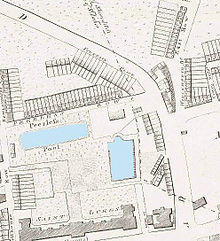Peerless pool

The Peerless Pool was the first public swimming pool in London . It was located in what is now the London Borough of Islington and was in operation from 1743 to 1850.
History and description
The Peerless Pool was located in London near the junction of Old and City Road (there is now a roundabout ), behind the former location of the St Luke’s psychiatric hospital in the Clerkenwell district . The pool was initially a natural pond that was fed by a spring and often overflowed its banks. The spring was one of the "ancient" springs that supplied the city with water, according to author William Hone . Even then it was used as a bathing area; since young men drowned in it several times, it was popularly known as Perilous (= dangerous) pool . On January 16, 1633, six young men died in the pond after they had broken into the ice. After this accident the ducking pond neere to Clearkenwell was temporarily filled in. The ducking pond was also popular for duck hunting .
In 1743, the London jeweler William Kemp acquired the site and had it redesigned, "to form the completest swimming-bath in the whole world" ("to design the most perfect swimming pool in the world"). He said that he was thinking about the common good, since bathing in the pond had gotten rid of his headaches himself. In order to achieve this, Kemp spared neither expense nor effort, according to historian William Maitland . The bottom of the pond was raised and the area was fenced in. In addition to a “luxurious swimming pool”, Kemp had walking paths, a bowling green and other facilities such as a small library built to turn the area into an attractive amusement park . The banks of the pond were planted with shrubs and trees. The Pleasure Bath was 52 meters long, over 30 meters wide and one to two meters deep. There was a 100 meter long canal where fish were released for anglers . There was also a cold bath that was twelve meters long and six meters wide. The pools were fed from the spring. Kemp gave the place the new name Peerless (= unique) pool .
Bathers (presumably only men) dressed in a marble - vestibule to, then rose marble stairs in the pond, the one surface made of fine gravel had. In winter the pond was used as an ice rink , and this was also one of the first in London. Dutch hydraulic engineers had brought their skates and introduced them to London. A visit cost one shilling , the annual subscription £ 1 and ten shillings, which was affordable only to the wealthier classes. In 1761, a scale model ship competition was held at the Peerless Pool to test the characteristics of ships.
William Hone wrote in 1826:
“On a summer evening it is amusing to survey the conduct of the bathers; some boldly dive, others timorous stand and then descend step by step, unwilling and slow; choice swimmers attract attention by divings and somersets, and the whole sheet of water sometimes rings with merriment. "
“On a summer evening it is amusing to watch the behavior of the bathers; some dive boldly, others stand fearfully and then descend, reluctantly and slowly, step by step; Excellent swimmers draw attention to themselves with jumps and somersaults, and sometimes the entire surface of the water resounds with joy. "
In 1805 the Peerless Pool was acquired by Joseph Watts. Baldwin Street was built on part of the site, for which purpose the fish pond was filled in. The amusement park was closed in 1850 and the property was built over. Except for the street names Peerless Street and Bath Street , nothing indicates the pool's earlier existence. The name of the nearby pubs Old Fountain in the Baldwin Street refers to the previous source.
reception
The Peerless Pool is mentioned in some books that are set in the Regency era, for example by Jane Austen and Georgette Heyer . In 2002 the crime thriller Death in the Peerless Pool by Deryn Lake was released .
Web links
Individual evidence
- ^ A b c d William Hone: The Every-day Book and Table Book or, Everlasting Calendar of Popular Amusements . tape 1 . Thomas Tegg and Son, London 1837, Sp. 971–977 (English, Textarchiv - Internet Archive ). It could have been a tributary to the Walbrook .
- ^ A b c Henry Benjamin Wheatley, Peter Cunningham: London Past and Present. Cambridge University Press, 2011, ISBN 978-1-108-02808-0 , p. 68 ( limited preview in Google Book Search - reprint, first edition 1891) doi: 10.1017 / CBO9780511920387 .
- ^ Peerless Street. In: thestreetnames.com. January 29, 2016, accessed April 6, 2020 .
- ↑ Skate Guard: Skating On The Moorfields: London's Peerless Pool. In: skateguard1.blogspot.com. September 20, 2016, accessed April 6, 2020 .
- ^ A b The Peerless Pool: London's First Outdoor Public Swimming Pool. In: janeaustensworld.wordpress.com. July 24, 2013, accessed April 6, 2020 .
- ↑ Model tests at Peerless Pool, 1761. Retrieved April 7, 2020 .
- ^ William Hone: The Every-day Book and Table Book or, Everlasting Calendar of Popular Amusements . tape 1 . Thomas Tegg and Son, London 1837, Sp. 974 (English, Textarchiv - Internet Archive ).
- ↑ Eric Chaline: Strokes of Genius. Reaction Books, London 2017, ISBN 978-1-78023-819-7 , p. 177 ( limited preview in Google book search).
- ^ The Old Fountain, Peerless Street. In: geograph.org.uk. June 27, 2008, accessed April 7, 2020 .
- ↑ Deryn Lake: Death in the Peerless Pool. Back-In-Print Books, London 2002, ISBN 1-903552-38-9 (reading sample, books.google.de ).
Coordinates: 51 ° 31 ′ 36 " N , 0 ° 5 ′ 18" W.

